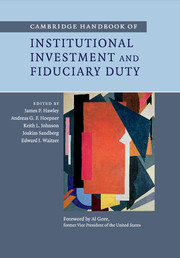Book contents
- Frontmatter
- Contents
- List of figures
- List of tables
- List of contributors
- Foreword
- 1 Introduction
- Part I Fiduciary duty: a global outlook
- Part II Fiduciary duty and the landscape of institutional investment
- Part III Challenging conventional wisdom on fiduciary duty
- 14 Is the search for excessive alpha a breach of fiduciary duty?
- 15 Fiduciary duty and sin stocks:is vice really nice?
- 16 Whose risk counts?
- 17 Sustainability, financial markets and systemic risk
- 18 Uncertain times, plural rationalities and the pension fiduciary
- 19 Emotional finance and the fiduciary responsibility of asset managers
- Part IV Towards a broader interpretation of fiduciary duty
- Part V Beneficiaries’ roles and viewpoints
- Part VI Fiduciary duty and governance
- Index
- References
16 - Whose risk counts?
Published online by Cambridge University Press: 05 April 2014
- Frontmatter
- Contents
- List of figures
- List of tables
- List of contributors
- Foreword
- 1 Introduction
- Part I Fiduciary duty: a global outlook
- Part II Fiduciary duty and the landscape of institutional investment
- Part III Challenging conventional wisdom on fiduciary duty
- 14 Is the search for excessive alpha a breach of fiduciary duty?
- 15 Fiduciary duty and sin stocks:is vice really nice?
- 16 Whose risk counts?
- 17 Sustainability, financial markets and systemic risk
- 18 Uncertain times, plural rationalities and the pension fiduciary
- 19 Emotional finance and the fiduciary responsibility of asset managers
- Part IV Towards a broader interpretation of fiduciary duty
- Part V Beneficiaries’ roles and viewpoints
- Part VI Fiduciary duty and governance
- Index
- References
Summary
In the expectations market the goal is to make a trade in which you have the upper hand, no matter what the impact is on the other party.
Roger Martin (2011: 32)Of all imaginary organisms – dragons, gods, sea monsters … – economic man is the dullest.
Gregory Bateson (1987: 175)This makes investors focus on returns without paying sufficient regard to the risks that are being taken to achieve these returns. Rarely do funds make their principal focus risk-adjusted return.
(Towers Watson 2012: 13)Introduction
The title of this chapter points to a deep unease the authors have about the workings of the investment industry. In an industry where the size of one’s “risk appetite” is a marker of one’s virility, where the biggest brains are drawn to interpreting the subtleties of the movements of markets, the dominant belief is that it is right that outsized financial rewards should go to those who deliver alpha (and clients). Our hypothesis is that, in this context, some simple and common sense truths about risk are ignored.
Here are some generalizations about the investment industry. In an industry where herd behavior is prevalent, the exceptions validate these norms.
- Type
- Chapter
- Information
- Publisher: Cambridge University PressPrint publication year: 2014



